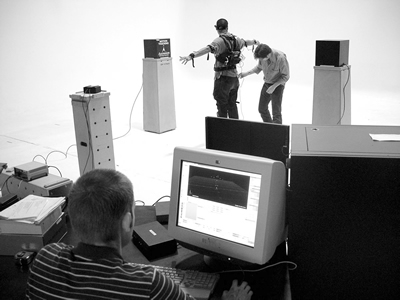|
Donated Film Equipment Enhances Entertainment / Animation Program |
|||||
|
|||||
| New technology will keep
CSUF students on cutting edge
April 21, 2005 They're make-believe characters, but in such films as "Lord of the Rings" and "The Polar Express," Gollum and the Conductor display remarkably real and natural human movements, through the magic of motion-capture technology. Thanks to a donation of motion-capture equipment valued at $88,000 from former Los Angeles media company 3D Bob, students in the entertainment arts/animation program are learning to use some of the same cutting edge tools that add realism to movies and computer games. Motion capture digitally records the movements of, in most instances, people so that the action can be played back with computer animation. Since it records only the movements of the actors, not their appearances, the performance recorded as animation data can be mapped onto a 3D model created by a computer artist. The animator can then take the model which can be a human, robot or other computer-generated character and impose the recorded behavior on them. How is this done? According to Dana Lamb, professor of art, "a set of straps with multiple sensors from head to toe is attached to an actor. A pack that also is attached to the actor has wires that run to a box that connects to the computer system. There are two boxes on pedestals that create the magnetic field around the actor that 'read' the movements of the sensors. This tells the computers where the actor's elbows, head, stomach, feet, etc. are during movement. "And, because the rebar in cement flooring can disturb the magnetic field, there's a modular wooden platform to raise the actor and boxes enough so that the computers can get a clean signal." The equipment is housed at Irvine-based Wild West Media, a company that is working in partnership with the entertainment art/animation program. As part of the partnership, Wild West pays for motion-capture specialist Kevin Schooler of Sony Pictures Imageworks to teach students how to use the technology. This first generation of trained students is developing their own training manual, and they, in turn, will teach their suc cessors. "Our foray into motion-capture technology is just one more victory in the battle to keep our students' education and career prospects current with an industry that changes is expectations in a matter of weeks or months," says Lamb. "Contributions of these kinds of equipment and training is the highest compliment we can receive from the studios, who only invest in schools that as one recruiter told me 'deliver the goods.' Our 'goods' being young talent with the determination, knowledge and creativity to hit the ground running." |
|
